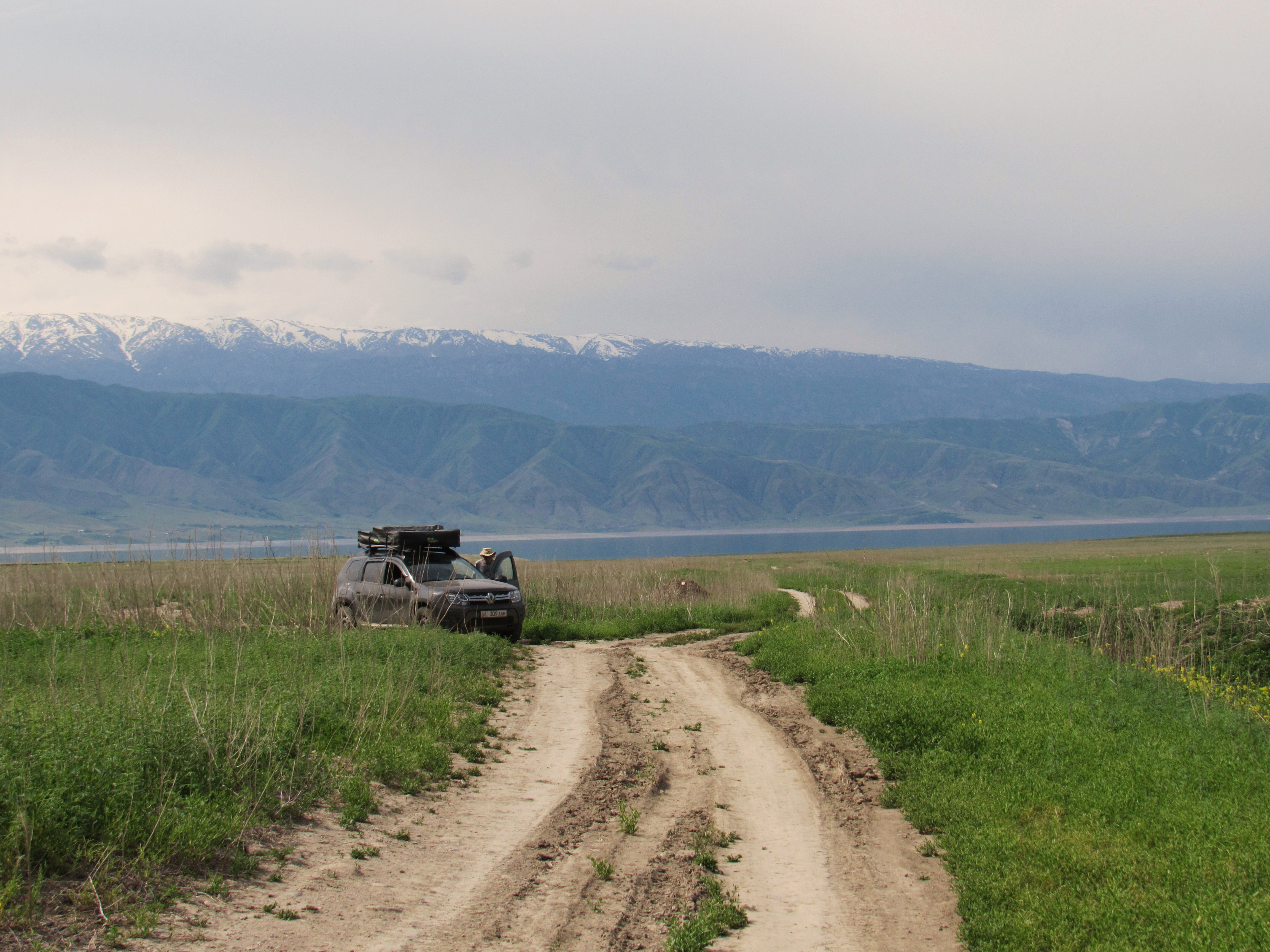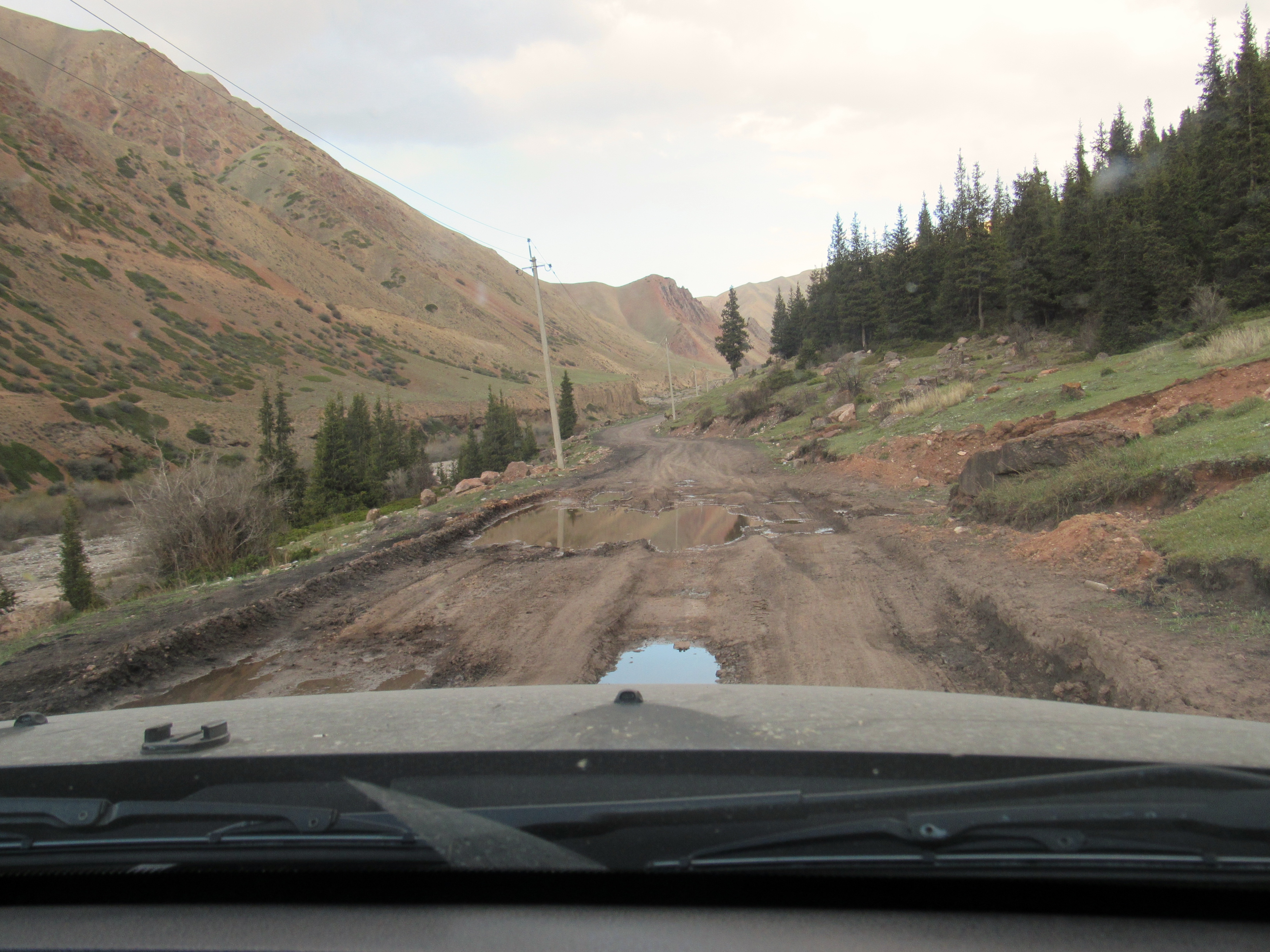Kyrgyzstan is all about the spectacular scenery. The Tian Shan (Heavenly) mountains cover most of the country. Pretty much the whole country is above 1500m and almost half is between 3000m and 7500m. In between the mountains are equally beautiful rivers and lakes. I had no idea that mountains and lakes could come in so many different colours and variations. Around every corner is another incredible panorama.
We spent a few days recovering from China in the lovely village of Sary Tash in the Alay Valley. Surrounded by the very high snow-covered mountains it is cold but idyllic. There’s one shop selling mainly biscuits and woolly socks, a petrol station and an ATM in someone’s house (without a sign). The famous Pamir highway runs through here.

Kyrgyzstan has one train that runs in the summer. Marshrutkas (small minibuses) are the main form of public transport. These don’t follow a set timetable but leave when they’re full. Otherwise it’s either hitch hiking or shared taxi. We decided to hire a car (Renault 4WD) for a couple of weeks so that we could get around and see the country. The car came with the optional extra of a rooftop tent and camping gear. Great idea we thought!
We set off driving from Sary Tash with no real plan in mind, but we did have a map that came with the car. It’s always strange, at first, to start driving in a new country where you don’t know the road rules and even more so when it’s the opposite side of the road to what you’re used to. In Kyrgyzstan they officially drive on the right but everyone I asked said ‘oh we just drive on whatever side we like’. This turned out to be true. After a while we did the same because the roads are atrocious. There’s one super modern highway that connects major centres, some secondary dirt roads and everything else is a goat track.
Everyone said it’s fine in Kyrgyzstan to park up and camp anywhere. This is called ‘wild’ camping. I like the sound of that. Traditionally nomadic, the Kyrgyz are still semi-nomadic and also camp wherever they like. In the summer, whole families move their small herds of cows, goats, sheep, horses and donkeys to the green summer pastures (jailoos). They assemble their yurts in a few hours and voila! instant home.


The nomadic Kyrgyz people migrated from Siberia sometime prior to the 17th century (possibly many hundreds of years earlier). Traditionally, people moved around freely across Central Asia, with a sensible disregard for arbitrary national borders. More recently, this region came under Russian rule in the 19th century and eventually became part of the Soviet Union. It’s been an independent democratic republic since 1991. Not long at all. Although predominantly Kyrgyz, there are also large populations of Uzbek and Russian descendants. There continues to be some ethnic disagreements between Kyrgyz and Uzbek communities in the south over land. Upstream cotton farming and climate change is creating water shortages and exacerbating tensions.
On our first day with a car we drove around for many hours through incredible scenery and eventually wandered along some goat tracks and came across the Papan Reservoir. We parked on the hill overlooking the beautiful lake, set up camp and thought ‘ah, this is the life’.

I’ve had a fascination with rooftop tents ever since I saw a family heading off to Africa with one on top of a Landrover many years ago. I now know that they don’t quite match up to my romantic notions. They’re quite difficult to put up and down until you get the hang of it. The advantage is that they do have a flat base with a comfortable mattress but this is kind of outweighed by having to climb down the treacherous ladder in the nighttime for toilet breaks. Even with a rooftop tent, camping is still overrated. What is the point of sleeping bags? The most uncomfortable impractical invention ever.

After building up our Kyrgyz driving skills we felt brave enough to head into the country’s second largest city of Osh – an ancient city with a continuous history of more than 3000 years. It’s bazaar is at least 2000 years old. It also has the most fabulous name. There are no old and amazing buildings in Osh though (or none that I could find) and although very pleasant it looks strangely Soviet and not at all ‘exotic Osh’. It’s like when someone’s called Peter but should obviously be called Dave. There is a big rock (or small mountain) right in the middle of town. It doesn’t look like much but is UNESCO World Heritage and revered as a sacred religious site stretching back for millennia. Its named after the prophet Solomon (Sulayman Mountain or Sulayman-Too) and is said to contain his grave. It was known as the halfway point marker between Asia and Europe on the old Silk Road.

Next stop is the picturesque village of Arslanbob in the Fergana Valley. It’s predominantly Uzbek and both peaceful and buzzing with village life – a beguiling place that’s hard to leave. It was getting late and we couldn’t find a suitable camping spot when we arrived, so decided to find some accommodation. We stayed in a wonderful homestay where our host, Husnadin, said that his family had been in Arslanbob for 35 generations. Husnadin had so many fascinating stories, told over breakfast of homemade bread and jams, or over dinner with his homemade (and surprisingly delicious) Walnut Wine. One of the many things he told us was that when a child is born 25 Poplar Trees are planted, so that by the time the child grows up, they have enough timber to build a house. Such a great custom.

Arslanbob is famous for walnuts and has the largest walnut forest on earth. It also supplies most of the world’s walnuts. The forest is 11,000 hectares of native walnut trees, up to 1000 years old. To see the forest we had to climb up the steep ridge above town. It was hard going but an amazing view from the top. The walnut trees are quite skinny, I think, for something so old. I guess the really old ones must be much deeper into the forest.


Many of the people in Kyrgyzstan appear to live a fairly simple rural life, in tune with nature and the seasons. The majority of families seem mostly self-sufficient. They all have vegetable gardens and fruit trees and make their own bread, jams, pickles and other foodstuffs. There are bee boxes everywhere and everyone has fresh honey. Weekly produce markets are the hub of every village.

The farming of animals is a big part of this traditional nomadic lifestyle. As a vegetarian I struggle with this one. On the one hand I see animals being tied up (hobbled) and killed for meat. I also saw and heard stories about how overgrazing is destroying the land. There are virtually no fences, which makes sense for a nomadic people. I love their lifestyle but can see it would be very difficult to sustain without the use of animals. They have small herds and know and care for each animal personally. This is how I assume it used to be everywhere, perhaps 60 years or so ago, before the evils of huge farms, petrochemicals, agribusiness and factory farming took over. They waste nothing and make so many things from milk (cheese, butter, yoghurt) plus the wool and leather is used to make yurts, shoes and clothing. They do extraordinarily beautiful felt work.

I’d read about Sary Chelek which was supposed to be the most beautiful lake in Kyrgyzstan. It’s a bit out of the way and we debated whether to make the effort to go and see it or not. In the end, we decided to just do it. The lake’s inside a protected zone (Biosphere Reserve) which means no farm animals grazing and so, hopefully, some wildlife. There’s no accommodation so it’s back to bloody camping. The road to Sary Chelek is long and difficult but the scenery is almost too beautiful to be true.

Climbing up into the park itself (1800m), we picked up a young hitchhiker from Belarus. He was carrying nothing but a skateboard but we let him out at the lake and he went on his way. Talk about travelling light! It was getting late and very cold. We stopped to set up camp and were just getting a fire together when along came a ranger on a horse and made us move. Damn. We had to set up camp twice.

There are supposed to be bears and snow leopards in Kyrgyzstan but we haven’t seen any wildlife at all, apart from a few birds. We didn’t see any at Sary Chelek either. So, off we went to yet another stunning lake at Toktogul Reservoir.


Our sort-of plan was to travel west to east across central Kyrgyzstan from Sary Chelek to Issyk-Kul and stay at a few lakes along the way. Song Kul would be our last stop before reaching Issyk-Kul. As we set off for Song Kul, JH is driving and I’m navigator. I’ve got a combination of Google maps, Apple maps, maps.me and the paper road map. On three of the maps it looks like Song Kul is sitting out there in space with no way to get there. On one map it looks like there’s a road branching off, at the village of Bashkaingdy, from the ‘main’ (said lightly) road we’re on. ‘Oh yes there’s a road’ I say (confidently). It started out rough and got worse.

We didn’t discover until later that Song Kul is an alpine lake, 3000m up and only accessible from June to September. It’s currently only mid-May. The scenery got wilder and the road got crazier as we wound our way up. It started to get downright spooky as we drove up through high ‘troll’ mountains and an isolated shipping container settlement. At one stage we realised we were driving through a coal mine.

The sky got darker, the rough dirt track wound around the edge of steep cliffs and JH started to say things like ‘this can’t be the right road’, ‘we can’t get there this way’. Not wanting to give up, I kept saying ‘it’s fine’, ‘look, the road’s on the map’. So we kept going until we reached the top and suddenly the road disappeared under a blanket of snow.

I got out and started walking through the snow to see if we could drive across and almost disappeared down a big hole. Uhoh that’s when reality hit and I realised I’d navigated us to a dead end. It was freezing and getting darker and then it started snowing heavily. Oh dear. Time to backtrack. We started making survival plans. At least we had a rooftop tent!

JH managed to drive us back down the mountain through the snow and I learned that maybe I should listen more. And probably be better prepared. Also, I don’t like camping.

Omg. I would have been crying.
And camping sucks. x
LikeLike
Haha. It does! Xx
LikeLike
Wow what an incredible journey. Stay safe you two x
LikeLike
Thanks Sarah 🙂 x
LikeLike
What a fabulous account of your journey I felt like I was there..thoroughly enjoyed reading this..well written..loved it..
LikeLike
Thanks Christina! 😘
LikeLike
How absolutely amazing!!!! I can imagine you saying’ it’ll be alright”!!!! What brilliant scenery and what an amazing part of the world you are exploring!!!
Its a bit remote for me so I think you are both very brave. Stay safe xx
LikeLike
It’s just stunningly beautiful Jules. Worth the effort xx
LikeLike